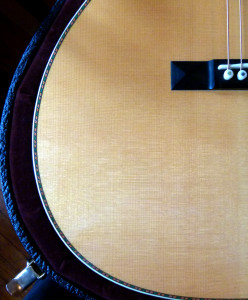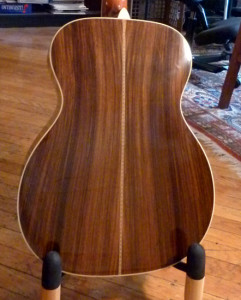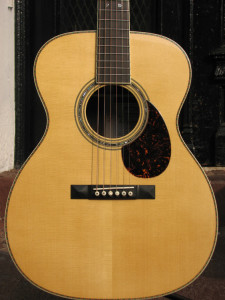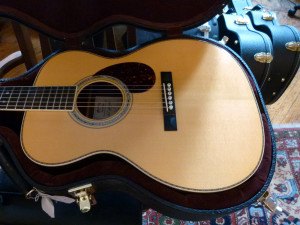Martin’s first deep body orchestra model,
the OM-30DB Pat Donohue turbocharges a classic design.
A champion fingerstylist’s dream guitar comes to life
OM-30DB Specifications include: special deep body 14-fret Auditorium size; solid Indian rosewood back and sides; solid Adirondack spruce top, scalloped 1/4″ bracing; one-piece, full-gloss, solid mahogany neck, modified V profile, 1-13/16” width at nut, slotted headstock; solid ebony fingerboard and pyramid bridge; bone nut and saddle; 2-5/16” string spacing; grained ivoroid body, neck and headstock binding; Style 30 colored wood top purfling and back strip; abalone snowflake fingerboard markers; Style 45 rosette; vintage Style 45 torch headstock inlay; abalone side position markers; fancy white tuner buttons with engraved golden plates
With versatility in mind, it combines powerful performance dynamics with refined styling not seen since Wilson was in the White House and Martins were made to be ornate but not ostentatious.
Worthy of a Champ
Pat Donohue is a national champion fingerstylist, who is equally proficient with a flatpick when playing in the many styles and genre required during his long participation as guitarist in the house band on Minnesota Public Radio’s A Prairie Home Companion, heard nationally on NPR. When honored by Martin with an special artist edition, Donohue knew he wanted a special guitar. Based on a vintage-style OM, he sought for more bass response and extra volume, as well as a little more room on the fretboard. That is exactly what co-designer Dick Boak came up with when creating the OM-30DB.
The signed label inside this particular example declares that it is #5 of the edition, which was completed with a total of 40 guitars. That makes it the third Donohue sold to the public, as the artist purchased #2 as a backup for the complimentary example he received from Martin. He couldn’t have been happier.
A Better Mousetrap
The OM, or Orchestra Model, is the Auditorium-size guitar design with the long-scale neck, which ushered in the era of the modern 14-fret acoustic guitar, when it debuted in Martin’s 1930 catalog. With their tighter waist and 4-1/8” depth, OMs are smaller than the boxy, bassier 14-fret dreadnought design that followed in 1934. As such, OMs provide a comfortable size, with a 1-3/4” neck and a string-to-string balance found nowhere else in the 14-fret world. From Roy Rodgers to Paul Simon, Laurence Juber to John Mayer, Martin OMs hold a special place in the history of popular guitar music.
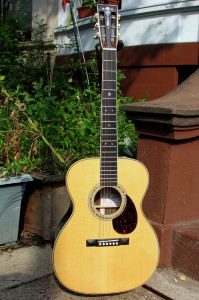 It is a design difficult to improve upon, especially for fingerstyle playing. But some people wish the string to string balance had a bit more of the extra bass heard from larger guitars. Others prefer the even wider necks and full-bodied tone of the traditional 12-fret Martin designs. This unique OM comes with some features that add some 12-fret flavor into the mix, and increase the lowest tone response at the bottom end. The most obvious change is the slotted headstock, rarely seen on a 14-fret guitar, along with the attractive torch inlay down the center. But other features have a greater impact on the guitars sound and playability.
It is a design difficult to improve upon, especially for fingerstyle playing. But some people wish the string to string balance had a bit more of the extra bass heard from larger guitars. Others prefer the even wider necks and full-bodied tone of the traditional 12-fret Martin designs. This unique OM comes with some features that add some 12-fret flavor into the mix, and increase the lowest tone response at the bottom end. The most obvious change is the slotted headstock, rarely seen on a 14-fret guitar, along with the attractive torch inlay down the center. But other features have a greater impact on the guitars sound and playability.
The OM-30DB Pat Donohue model has a 1-13/16” width to the ebony fingerboard, on the one-piece mahogany neck, splitting the difference between an OM’s 1-3/4” and a 12-fretter’s 1-7/8”. The modified V profile is on the shallow side, making the neck feel narrower in the palm than it actually is, while providing just a bit more open space between the strings and a sense freedom, with fingers being less crowded when playing stacked chords, or when doing bends and waggles of individual strings without crashing into adjacent strings.
It also has the straight pyramid bridge, which has a smaller footprint on the spruce soundboard, allowing for even more flexibility. Martin featured their version of the Spanish-style straight bridge for nearly 100 years before switching to the modern belly bridge in 1930, made to add extra anchoring power against the tension of steel strings. Only the very first OMs had the pyramid bridge, believed to contribute to the expansive tonal properties and sensitivity of those legendary fingerstyle guitars.
Muscle Tone
A major contributor to the extraordinary voice of the OM-30DB, is the DB, which stands for Deep Body. It is made with sides 1/2″ deeper at the end pin than on a regular OM. The results are incredibly successful.
The traditional OM sound is balanced across the strings, with the A string slightly more dominant in the low end, rather than the bottom-most low E string. There is good separation between the fundamental strings, abnormally good projection for the body size, and an overall voice that expands in all directions. If one wishes to increase volume and or bass response on a guitar, there are three major options – make the body longer, the top wider, or the sides deeper.
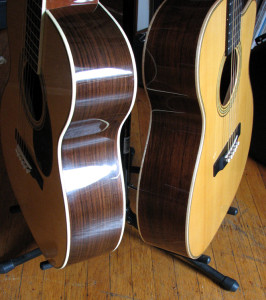
The elongated 12-fret design provides good volume, and a throbbing swell in the bass and low-mids, while removing the availability of the uppermost frets. The Grand Auditorium, or M size, has the same side depth of an OM, but a wider top. They too have good volume, and a voice with a punchy midrange, braced by a defined low E string, which makes me think of a dreadnought voice that has the bass pulled back down almost in line with the other registers. Only the deep body OM manages to keep the classic OM voice, with it open space between the top notes, the expansive projection in all directions, and that string to string balance, until you get to the low E string, where the EQ is kicked up a notch, so it never gets lost during alternate thumb picking patterns, or when playing with other musicians.
The voice on this deep body OM is large but lovely, with forthright fundamentals like a piano and the bass of a baby grand, backed by an expansive undertone, open beneath the highs but with a warm, Indian rosewood presence emanating from the beefy bottom end. Now 6 years old, the guitar has blossomed into a magnificent piece of luthiery.
The resonance has increased over time, and the harmonics bloom from just about every string at every position, often accompanied by ultra-high Adirondack angels. When playing with a pick, it has just enough added oomph in the low E string to satisfy those who miss the throb heard on the bottom edge of a dreadnought or 12-fret 000. And chords have a palpable throatiness across the low-mids and bass, which sound a lot like an “acoustic Les Paul,” if there could be such a thing.
Good Wood
The Indian rosewood on the sides is banded; dark, chocolaty, and straight, until the bands rise in a decorative and perfectly bookmatched slope where they meet at the end strip. The back has very nice color delineation, with light and dark banding reminiscent of the Indian rosewood from the early 1970s, when they first started using that wood for backs and sides. There is a lighter area on either side of the Style 30 back strip, darker bands in the center of each half, with mixed striping of dark and light near the outer edge. And at either end of the colorful back strip there is a sort of arrow fin Y to the grain, which looks like an artist painted it on purpose.
Actually, Great Wood
The Adirondack spruce is a good example of a great Martin top, with grain typical for that found on high-end Martins, tight in the center, at some 38 lines per inch, widening out to 17 lines per inch at the edges of the lower bout, where you want the most flexibility. But at the widest, it is still tight grain by Adirondack standards.
However, there is considerable cross grain on this perfectly book matched top, full of ripple and silking beyond what Adirondack typically offers. It just looks like a serious piece of wood, and it has proven itself, breaking in and opening up to offer more depth, resonance and complexity over time. This is without question the best spruce top I personally have found on a modern-day Martin guitar. It is so alive, so reflective and responsive, providing incredible definition, effortless volume, chime, headroom – all the qualities one hopes for in Adirondack spruce. And that deep rosewood body gives it a lot of powerful tone to play with.
With Indian rosewood back and sides and an Adirondack spruce top, it is related to the OM-28 Marquis when it comes to tonal color – rich with warmth in the bass, but with pure, ringing trebles and mids of great definition. However, the dynamics are different from the Marquis, which comes with lighter, Golden Era style bracing. The OM-30DB has the same bracing used on the OM-42 and OM-28V, which offers fatter treble notes, and allows the top to be driven harder without bumping its head on the ceiling and getting all thin and buzzy. In fact, there really isn’t an attack ceiling. But given the extra volume from the deeper body I never need to play that hard anyway.
The Indian rosewood puts its special thick, woody warmth under the hood but the Adirondack top voice is bold and clear, and the harmonics are all sleek lines and glistening glints. It is a fine example of the best facets that Indian and Adi have to offer, with all the dynamics, power, volume and projection controls tweaked just a little higher. You might say it is a turbocharged Martin OM.
It has an OM’s classic separation between the fundamental notes, each ringing out with the lightest playing, and popping out with only a slight increase. Yet it has a deeper swelling from the undertone and a low E string with a good, hard punch when played with a pick,which just might bring a tear to a fingerpicker’s eye. That makes it seriously versatile, as it works very well to hold down the bassy rhythm when it’s the only guitar in a combo. And it sure loves dropping that low E down to D.
Style 30 Resurrected
This is the first Martin guitar made in Style 30 for 80 years, filling a gap that existed for much of the 14-fret era, between Style 28 and the pearl trim guitars from the 40+ Styles. Style 35 was invented in 1966, when the company wanted to start using three-piece backs to find use for their store of rosewood slats that weren’t big enough for a two piece back. So, it was more like Style 28 than vintage 30s, but given a bound neck to set it apart. Styles 36 and 38 evolved from Style 35.
Style 30 is one of the original styles from the vintage era, with proto-examples from the 1840s. It was retired from the Martin catalog in 1917, although examples have surfaced from as late as 1921. The major feature is the multicolor wooden marquetry used for the trim around the top and back strip, as well as a abalone rosette, set off by various patterns of snowflake fingerboard markers, depending upon the exact year of production.
In the years before fingerboard markings, Style 30 appears no different than the older and more obscure Style 27, with the exception of higher grade tuning machines. And in some years, Style 34 appears to have been identical, except for the added feature of a bridge made from elephant ivory. But Styles 27 and 34 were long gone by the First World War. It is the Style 30 from that era which is recreated in the new Pat Donohue model.
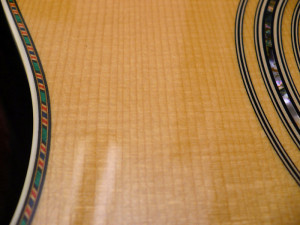 This Style 30 instrument has fingerboard markers in a vintage 5-7-9 “short pattern” and an busy abalone sound hole rosette, along with the brightly colored trim around the edge of the top. The fingerboard markers consist of a 6-point snowflake at the 5th fret, two small, slotted diamonds at the 7th fret and a 4-point snowflake at the 9th fret. And to signify the Pat Donohue signature model, the 12th fret features his initials, P D, inlaid like the others in high-color abalone pearl. I could take or leave that addition. But I certainly prefer it to the typical celebrity autographed signature inlaid in script. What I like about the initials is the fact that from the audience or from across the room, it looks like typical fret markers and extends the old 12-fret fingerboard inlays for the 14-fret design.
This Style 30 instrument has fingerboard markers in a vintage 5-7-9 “short pattern” and an busy abalone sound hole rosette, along with the brightly colored trim around the edge of the top. The fingerboard markers consist of a 6-point snowflake at the 5th fret, two small, slotted diamonds at the 7th fret and a 4-point snowflake at the 9th fret. And to signify the Pat Donohue signature model, the 12th fret features his initials, P D, inlaid like the others in high-color abalone pearl. I could take or leave that addition. But I certainly prefer it to the typical celebrity autographed signature inlaid in script. What I like about the initials is the fact that from the audience or from across the room, it looks like typical fret markers and extends the old 12-fret fingerboard inlays for the 14-fret design.
What catches everyone’s eye on Style 30 is the purfling around the top, which has not been seen on a Martin since Woodrow Wilson was in the White House. The wooden marquetry consists of longer green dashes trimmed in black and gold, and separated by a series of short slashes in yellow, red, and blue. The back strip has the same pattern, only trimmed with golden borders of natural wood running the length of the strip.
Vintage Style 30 had a blank faceplate on the headstock, but I am not about to complain that this guitar sports my favorite faceplate design – the abalone “torch” pattern found on the top-of-the-line Style 45 Martins made in the 1920s, on up through the 1930 OM-45 Deluxe. Whoever the inlay artist was, they did an extra special job on this one. This is my all-time favorite torch.
Other details of interest include the full gloss neck, usually reserved for more expensive Martins, as are the engraved golden tuning plates for the three-on-a-side ivoroid tuning buttons, and the extra touch of abalone used the side position markers, which look nice, but also serve the practical purpose of remaining visible in even the darkest stage lights due to their reflective quality.
Tasteful Splendor
While a 14-fret slothead is a rare bird, recent scholarship has discovered that the very first 14-fret Martin, made in 1929 as a special order for popular bandleader Perry Bechtel, did indeed sport a slotted headstock. In fact, it was a 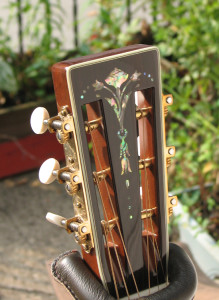 limited-edition historical recreation of that guitar which led to Donohue’s decision to go with a similar look, only with the addition of the deep body design, and opulent amenities.
limited-edition historical recreation of that guitar which led to Donohue’s decision to go with a similar look, only with the addition of the deep body design, and opulent amenities.
Similar to some special models made for concert masters from the early 1900s, this OM-30DB is a high-end Martin without the flashy pearl inlay around the top. So it has a woodier aesthetic, but no less colorful. The grained ivoroid binding on the body, the neck, and the headstock, with each finished in the full high-gloss of the 40-level Martins, and the sumptuous details of the headstock and fingerboard, all provide that added sense of luxury.
But it is the prime tonewoods, the 1/4″ scalloped braces, and the extra deep OM body that provide the magic making this a very special and seriously versatile Martin guitar.
And that is one man’s word on…
Martin OM-30DB Pat Donohue model
More Photos HERE
Other Martin Reviews
Authentic Series – in-depth reviews of all of them
Official OM-30DB Spec Sheet
Retail: $6,799.00 ea.
Construction: Mahogany Blocks/Dovetail Neck Joint
Body Size: 000-14 Fret – Deep Body
Top: Solid Adirondack Spruce
Rosette: Style 45
Top Bracing Pattern: Standard ”X” Scalloped
Top Braces: Solid Adirondack Spruce 1/4”
Back Material: Solid East Indian Rosewood
Back Purfling: Style 30
Side Material: Solid East Indian Rosewood
Endpiece: Grained Ivoroid
Endpiece Inlay: Black/White Boltaron
Binding: Grained Ivoroid
Top Inlay Style: Style 30
Side Inlay: none
Back Inlay: Black/White Boltaron
Neck Material: Genuine Mahogany
Neck Shape: Modified V
Nut Material: Bone
Headstock: Slotted/Square Slots/Diamond/Square Taper
Headplate: Solid East Indian Rosewood /Torch Pattern – Select Abalone Pearl
Heelcap: Grained Ivoroid
Fingerboard Material: Solid Black Ebony
Scale Length: 25.4”
Number of Frets Clear: 14
Number of Frets Total: 20
Fingerboard Width at Nut: 1-13/16”
Fingerboard Width at 12th Fret: 2-5/16”
Fingerboard Position Inlays: Style 30 Abalone
Fingerboard Binding: Grained Ivoroid
Finish Back & Sides: Polished Gloss
Finish Top: Polished Gloss w/ Aging Toner
Finish Neck: Polished Gloss
Bridge Material: Solid Black Ebony
Bridge Style: Pyramid w/ Drop-In Saddle
Bridge String Spacing: 2-5/16”
Saddle: 16” Radius/Compensated/Fossilized Ivory
Tuning Machines: Waverly w/ Small Ivoroid Buttons
Recommended Strings: Martin Studio Performance Light Phosphor Bronze (MSP4100)
Bridge & End Pins: Camel Bone w/ Select Pearl Dots
Pickguard: Delmar Tortoise Color
Case: 533E Geib style
Interior Label: Signed by Pat Donohue, Numbered In Sequence
